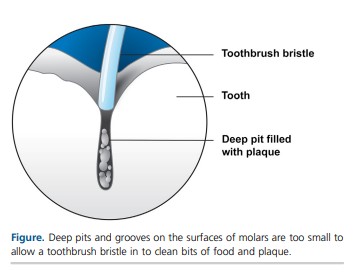
Reducing the Risk of Cavities with Sealants
All teeth have a coating of bacteria on them. It is called plaque. When this plaque comes in contact with sugars in foods or drinks, it produces acid that can break down the tooth and cause cavities.
Developing Cavities
Cavities can develop as soon as the first tooth breaks through the gums. One study found that almost 1 of 4 teeth in children 2 to 5 years of age had treated or untreated cavities. As children got older, the number of cavities doubled.
Many of the older children in this study had their permanent molars, the big teeth in the back of the mouth. These teeth develop most of the cavities. These teeth are at higher risk of cavities because the chewing surfaces are not smooth. These surfaces have deep pits and grooves that can trap food and plaque, creating a space for cavities to develop.
Preventing Cavities
Brushing your teeth twice per day with a fluoride toothpaste is a good way to reduce the risk of cavities. Unfortunately, the pits and grooves in molars are too small for a toothbrush bristle to get into, and so the food and plaque can build up. (Figure)
Sealants are plastic coatings that your dentist can paint over the molars’ surface. They can help reduce the risk of cavities on molar surfaces. Before applying the sealant, the dentist will clean the surface of the molar and treat it so that the sealant will stay in place. When they dry, sealants provide a smooth surface and cover the pits and grooves to block them from the build-up of food and plaque.
Sealants can offer protection for a number of years. Researchers have found that sealants protect against 80% of cavities over the first 2 years after placement.
Getting Sealants
It is best if sealants are applied to permanent molars soon after they come into the child’s mouth. Once they dry, sealants can last a number of years. Although they typically remain in place, it is possible for them to come off or wear down. Because of that, if your child’s dentist notices a sealant is missing or worn at a regular dental visit, he or she may recommend replacing or patching it.
Reducing the risk of cavities with sealants (ada.org)
Leave a reply →